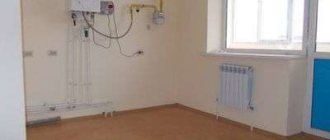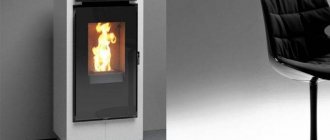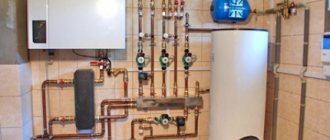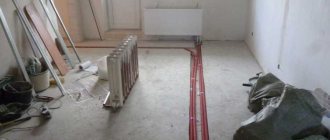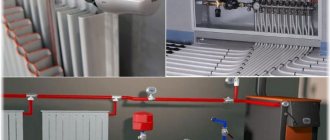Advantages and disadvantages
Advantages
Let's take a closer look at the second option and determine its positive and negative sides. First, let's figure out what an autonomous heating point is. This is a separate room where boiler equipment is located, the power of which is sufficient to provide heat and hot water to the entire apartment building. This is a kind of mini-boiler room with a full set of necessary instruments, fixtures and systems. Modern technologies for providing heat to residential buildings have begun to be used in autonomous systems. The latter worked for one or several houses, which was doubly profitable. Why?
- Firstly, the distance from the heat generator to the heating devices in each apartment has been significantly reduced. This means that heat loss has decreased due to the transportation of coolant.
- Secondly, the time for supplying heat to the consumer has been reduced, which is again due to a decrease in distance.
- Thirdly, the costs of maintaining heating networks, their repair and installation have changed less.
- Fourth, economic indicators resulting from previous benefits have declined. This means that the cost of the supplied coolant has changed to a minimum.
Autonomous system diagram
There is one more advantage of the system. When a house is being built, the developer is required to obtain a large number of permits that will allow him to crash into the central highway. Bureaucratic delays sometimes take months. And the installation of a metering device will cause a lot of disputes between developers and the receiving party, that is, the operating company. So for builders, option c, even for the largest house, is ideal.
And the last advantage is that the boiler room for the microdistrict occupies a place where not only buildings and water tanks will be erected, but also an electrical substation, access roads, warehouses, office premises, administrative buildings, etc. That is, a fairly impressive area will have to be allocated for it. And if there is no longer a need for a boiler room, the district administration can use this area for its own needs. For example, build another residential building, school, clinic, etc.
Flaws
Gas boilers
There are disadvantages in any system, but they are usually fewer:
- An autonomous boiler room must be located in a separate building, so it is necessary to allocate an area near the house for it. Sometimes such a building takes the form of an extension.
- Mini-boiler houses pollute the environment to a certain extent. Therefore, it is impossible to do without modern cleaning devices. And being located inside microdistricts obliges us to create conditions for environmentally friendly operating indicators. They exist and are stipulated by the norms and rules of SNiP. Hence the increase in the cost of the equipment itself.
- The autonomous heating system is not yet as popular as the centralized one, so the production of equipment and related components has not yet been put into production. Hence the high cost of such systems. This means that not all developers can afford them.
Heating regulator
However, experts say that engineering developments today can eliminate some of the shortcomings. For example, if an autonomous boiler room is used to heat only one apartment building, its equipment can be placed in the attic - the dimensions of the devices allow this to be done. In addition, the attic immediately becomes heated, which is undoubtedly a plus. In addition, the area between the houses is freed up. The only requirement for such options is the presence of a flat roof, which is not a problem. If you plan to install just such a heating system, you can add a flat roof to the project. Experts have already carried out preliminary calculations, which have shown that even if the cost of equipment and installation costs are high, it will all pay off in a few seasons.
Pros and cons of installing a gas boiler in an apartment
It should be noted right away that the first advantage that gas heating provides is cost savings. Often people living in apartment buildings simply do not understand why they are overpaying money. In the case of installing individual heating, such misunderstandings do not arise.
The second plus is an autonomous heating system, independence from the supply of hot water from suppliers. Gas shortages are rare here.
The ability to regulate temperature is another advantage. After all, the comfortable temperature in the room depends on this. In addition, you will never depend on the season: at any time you can turn on the heating and create a cozy atmosphere.
As mentioned above, in addition to heating the room, there is the option of using hot water.
The disadvantages include the high cost of the unit and its subsequent repair if a breakdown occurs.
Paperwork and its difficulties
If usually the catalyst for all problems is the amount of money for the service, then in the case of autonomous heating it is the collection of all necessary confirmations and permits for installation.
In addition, permission may not be obtained at all, since officials are very reluctant to cooperate and may simply stall the issue, especially if the apartment in the building is the only one that claims heating independence. If a refusal occurs, then it is imperative to convene a commission, which, with the support of independent experts, will have to justify the decision of the utilities and make a final verdict.
On the other hand, if the house is not an apartment building, but your own, then the problems become much less. This is due to the fact that you can simply contact an installation company that will solve all problems: from obtaining the necessary documents to installing the boiler.
Gas roof boiler room
The device has the following positive aspects:
- High efficiency. Thanks to the use of liquefied gas, which releases energy when heated, fuel consumption is reduced.
- There are almost no external communications. This reduces costs. Heat loss is also reduced.
- In low buildings (up to 26 m) there are no additional installation requirements, which reduces the cost of the project.
- Automation, which reduces operating costs.
- The device is not turned off for annual inspection, which allows daily use of hot water.
The device has several limitations. To accommodate the boiler room, the roof is strengthened by installing a concrete pad. Preliminarily calculate the load that the building can withstand.
Special equipment is brought in for installation, the operation of which creates inconvenience for residents. The cost is also unpleasant: the costs go towards creating the project, laying the gas carrier, and the automation responsible for control. Additionally, protective measures and a fire extinguishing system are installed.
Benefits of Autonomous Systems
Autonomous heat supply of an apartment building brings many advantages to its owners:
- The heat supply of an apartment building is almost completely automated, so you can set a certain temperature regime and it will be respected by the device. In addition, it will be possible to set minimum temperature parameters in case of departure, so that excess heat will not go into emptiness.
- Autonomy allows you to depend only on yourself, so constant pipe breaks at utility companies will no longer turn off the heating. While many will wait for the heating to return, the owner of autonomous heating in the apartment can safely warm up in his apartment.
- The devices undergo technical testing, so breakdowns occur extremely rarely and you can fully rely on the heating system and not be afraid of turning off the heat supply at the most inopportune moment.
Electric heating systems
Today, electrical equipment for decentralized heating is considered the most economical. The operation of such devices, as a rule, uses the principle of polarization of water under the influence of alternating current.
Connecting one apartment involves a simple autonomous system with the installation of an electric boiler with an anode operating principle. The use of dual-circuit systems suggests the possibility of installing heated floors through a separate circuit. For small rooms, the best option would be special batteries with individual heating, which allow you to independently regulate the heat levels.
A more complex process is converting an entire residential building to an autonomous electrical system. To do this, you should first resolve issues with the substation and calculate the expected load on the electrical network in accordance with the power of the transformer. If necessary, switchgear devices should be replaced. This event must be agreed upon with the energy company.
Important! Most older systems and wiring will not be able to handle high loads. Therefore, in a house switched to autonomous heating, it is recommended to replace incandescent lamps with LED sources, as well as reduce other energy costs
Arguments against:
- Equipment explosion hazard;
- Risk of gas leaks;
- The high price of equipment included in the price of the apartment upon purchase.
Another negative factor against an individual heating system is the fact that, by law, construction companies only provide a 5-year warranty on equipment , and meanwhile, the pipes for the heating system are hidden in the floor. If there is a leak, then problems with repair cannot be avoided.
The new technology is also not in favor of the regular additional costs that fall on the apartment owner for servicing their autonomous heating system. You can probably study the scientific and technical documentation yourself and become an expert in this field, but still, a gas boiler is a technically quite complex installation. Therefore, the state says that in order to avoid man-made threats, the owner is obliged to enter into an agreement for the maintenance of his gas equipment, and has established a fine for failure to comply with this norm.
As we can see, each heating system has its own advantages and disadvantages. But still, if we proceed from the main criterion for the majority of our fellow citizens, namely the cost-effectiveness of future heating payments, then individual heating is more attractive. Even though the owner must additionally maintain gas equipment, this remains more profitable than heating the street from his own pocket. The benefits are obvious not only for consumers, but also for construction companies, and even for executive authorities, who will not need to pay subsidies for utilities.
Unfortunately, the owner of an apartment building cannot independently switch to autonomous heating. This is prohibited according to paragraph 15 of Article 14 of the Federal Law of the Russian Federation No. 190 “On Heat Supply”. Therefore, if you decide to buy an apartment in a new apartment building, you should select in advance new buildings with gas heating, which initially provide for the installation of this system.
Gas heating
As a rule, apartment owners face a choice between two types of alternative heat sources:
- Designs based on a gas boiler.
- Electric heating systems.
Gas heating has a number of advantages:
- Modern boilers are equipped with an increased security system and operate autonomously. maintaining the level of heat that residents need.
- Such boilers have small dimensions. therefore, they can be installed in even small rooms.
- It is easy to install, so with proper attention and some tools and skills, even a beginner can do it.
- Autonomous gas heating in the apartment is equipped with a chimney system and does not have to be installed separately.
- Gas boilers operate absolutely silently. so that they will not cause complaints from neighbors.
- An affordable price and complete set of all components and parts make gas heating the most common choice among consumers.
When installing new heating, the old system must be dismantled. It is easier and cheaper to install new radiators than to try to fit old ones to it. Although modern gas boilers have the highest degree of protection, gas leakage is still possible.
Advantages and disadvantages of independent heating
To understand which heating is better and whether it is necessary to abandon central heating in favor of autonomous heating, it is necessary to determine the advantages and disadvantages of a separate option:
Advantages:
- significant savings. As the owners themselves, who switched to autonomous gas heating, note, the cost of heating their home is reduced by 7 times;
- complete independence from the start and end of the heating season;
- the ability to independently control the temperature. Some devices allow you to set the desired mode in which the heating level changes over a certain period of time. For example, when all family members are at work or school, the temperature drops by several degrees, and in the evening it increases again. This allows you to save even more;
- uninterrupted supply of hot water;
- independent choice of radiators. Any batteries are suitable for an individual system, since there is no likelihood of water hammer.
We recommend: How much does autonomous heating cost?
Minuses:
- high price of the device;
- dependence of modern boiler models on power supply;
- the need to install a new heating device;
- in many situations it is necessary to install a suitable exhaust duct.
Useful features of an automated autonomous system
Almost every autonomous heating system is equipped with a number of functions that greatly simplify the life of its owners:
- Automated systems can detect sudden changes in temperature outside, adjusting the internal climate of the room as needed. Thanks to this, even in the absence of the owners of the home, the temperature will not drop, and the boiler will start heating the water on time.
- If the temperature outside rises, the system will reduce energy consumption while maintaining the same indoor temperature.
- Automatic systems are capable of reducing performance day and night, but at the same time pumping up heat in the evening and morning when it is most needed. Thanks to this, a pleasant temperature regime is created in the room, and fuel is not consumed unnecessarily.
- The system can be equipped with a room temperature sensor. To do this, it is installed in rooms not combined with the boiler room. If there is a change in temperature, the heating system starts and regulates the temperature in the desired direction.
Disadvantages of individual heating
Of course, along with serious advantages, autonomous heating systems also have a number of disadvantages. For example, the impossibility of operating the system without gas supply. Yes, today there is an accelerated gasification of the entire country, but we should not forget that gas is an irreplaceable natural resource with limited reserves. Let's hope that there will be enough for our lifetime, and exports to China will not affect future rent prices for our children.
Speaking seriously, the economic component of this issue lies on a slightly different plane. When moving into a new building with autonomous heating, not all residents immediately move into their new apartments. It's good if this is the case in the summer. But in winter you will have to pay for cold walls from your absent neighbor, which will not have a very pleasant effect on further relationships between some residents of the house. In addition, gas consumption for heating will be different for residents of medium-sized and corner apartments.
Selection of fuel and boiler
Gas is most often used for automatic heating systems, as it is one of the cheapest natural resources. In addition, many boilers are designed specifically for it and can be placed both on the floor and on the wall.
As for the boiler itself, the key choice here is between cast iron or steel equipment.
Steel boilers are susceptible to corrosion, and therefore are not as durable as cast iron models. On the other hand, installing a steel unit is much easier than a cast iron one due to the weight of the device. In addition, a steel boiler is much easier to hang on the wall, which is why most of these models are made from this material.
How to calculate the cost of autonomous heating, see the example in the video:
Looking for a solution
So, what kind of heating is best for an apartment? First of all, it would be worthwhile to understand what kind of autonomous heating systems that would be suitable for an apartment exist.
We immediately reject systems based on solid and liquid fuel boilers. Increased fire hazard, difficulties with smoke removal and fuel storage, not to mention the fact that simply no one will allow such a system to be installed in an apartment. There were often cases when overly businesslike owners arranged something similar in an apartment, but it always ended in dismantling and huge fines. All these options are only for a private house, dacha, cottage.
But as for gas boilers and “warm floor” systems, there is already plenty to choose from in order to decide which heating is best for the apartment.
The attentive reader probably noticed that we did not mention the usual electric convectors, fan heaters and other air heaters. Unfortunately, such devices are extremely difficult to seriously consider as the main heating system of an apartment. In any case, it’s either noise, or extreme uneven heating of the room, or sky-high electricity bills, and most likely all of this together, plus the same fire risks.
Procedure for disconnecting from the centralized heating system
When preparing all the necessary documents for the transition to individual heating of housing, it is necessary to study the relevant legislation:
- Federal Law No. 190 of July 27, 2010;
- Decree of the Government of the Russian Federation No. 307 of April 16, 2012;
- Art. 25, 26 of the Housing Code of the Russian Federation.
The simplest solution would be to install an electric boiler. You just need to make an application and submit it to the district electrical network. If the technical conditions are appropriate, the permit will be issued quickly. But the heat generated in this case may exceed the cost of thermal energy from centralized heating.
Therefore, installing a gas boiler is more profitable in terms of cost savings, since the cost of natural gas is relatively low. But when carrying out individual gas heating, you will have to comply with many formalities:
You must obtain the appropriate technical specifications from the city gas service. Check the chimney for serviceability and obtain a conclusion about this from the All-Russian Voluntary Firefighting Society (VDPO). Obtain the consent of the remaining residents of the house (this point is specified in Part 3 of Article 36 of the Housing Code of the Russian Federation)
This is very important, because if one apartment refuses centralized heating, malfunctions in the operation of the entire system may occur. In addition, it is necessary to obtain relevant documents and find out who owns system elements such as batteries and piping
If they are in common property, it is also necessary to obtain special permission from the neighbors. If the heating components are not common property, permission to disconnect must be obtained from the management company. In city heating networks, obtain the right to dismantle the heating system in your apartment.
For those residents who have gas water heaters installed in their apartments, it will be easier to obtain permission for individual heating, since such buildings have a chimney, and the pressure in the gas pipeline is suitable for the operation of a gas boiler.
Having received preliminary permission for a gas heating project, you should prepare the following documents:
- A statement in which you must indicate that the owner of the apartment plans to make individual heating and disconnect from the centralized system.
- The original registration certificate of the apartment, which should indicate the location of the batteries and pipes.
- Permission from the residents of the house (if the system components are common property) or from the management company.
- Decision on possible redevelopment of the apartment. It is issued by the housing office or management company.
The period for obtaining permission to dismantle the centralized system and install an individual one can last from 3 months to six months. Once permission has been received from representatives of the utility service, you can proceed to dismantling the heating elements in the apartment.
Is it legal to install an individual heating system?
There are many disputes and lawsuits on the legality of installing autonomous heat supply equipment in a separate apartment. It all started with the fact that in 2010 the Russian government banned the disconnection from general heating supply and the transition to individual heating, forcing many people to give up. But in 2012, a new law was adopted that concerns the procedure for connecting heating systems.
It notes a list of heat sources that are prohibited for use in apartments. This list does not include modern certified heating boilers. Consequently, the law does not prohibit the installation of your own heating, and all restrictions relate only to the technical features of heating systems.
This does not mean that the owner of the premises can freely install individual heating. Before doing this, it is important to obtain permission from local authorities. If the administration does not issue it to you, go to court, since such a refusal is illegal.
How to get permission?
For permission to install autonomous heating, you must contact the district administration, which is responsible for the use of the housing stock. Within 1.5 months, officials give an official response. From the administration you can obtain a list of documents that must be provided to obtain permission.
List of documents
Since the installation of the heating system itself relates to the refurbishment of a residential premises, the document will consist of the following documents:
- a statement written in accordance with a special form;
- documents of apartment ownership: certificate of state registration, deed of transfer of ownership, gift agreement, document confirming the right of inheritance;
- certified copies for each owner and a statement signed by all owners.
- a copy of the technical passport of the premises;
- consent of family members of the tenant and residents of the multi-storey building, drawn up in the form of minutes of the meeting of apartment owners;
- conclusion of the body responsible for the protection of architectural monuments, historical or cultural heritage on the possibility of organizing redevelopment.
We recommend: How to install autonomous heating in a private house?
The hardest part is preparing and providing technical documentation. It is customary to include:
- redevelopment plan for the installation of gas equipment, consisting of gasification of the premises and changes to the central heating system;
- a duplicate of the passport for the electric boiler, technical conditions, agreement, which confirms the permission of the maximum power exceeding the capabilities of the equipment;
- Specifications for disconnecting the wiring in the apartment from the public heating system;
- Specifications for ventilation;
- Specifications for supplying gas networks.
What to do when obtaining permission?
If you did everything correctly and received a positive verdict, you need to buy equipment and enter into an agreement with a company that installs autonomous heating. After completing the re-equipment and carrying out all the work on installing the new system, it is necessary to officially formalize the installation of individual heating. If your budget allows, you can save yourself from bureaucracy and entrust this task to a design service for a fee. Now you know the difference between autonomous heating and individual heating.
YouTube responded with an error: The request cannot be completed because you have exceeded your quota.
- Related Posts
- Advantages of autonomous gas heating
- Types of autonomous heating of industrial premises
- How to make autonomous heating in a private house?
- How much does autonomous heating cost?
- How to make autonomous heating for a garage?
- Is it possible to install autonomous heating in an apartment building?
Selection of pipes, boiler and radiators
The operation of the entire system depends on the correct choice of boiler.
For example, if you need to install a boiler to heat water, then you can get by with a single-circuit gas boiler.
When choosing gas heating, it is better to purchase a boiler made of cast iron or special durable metal. Although they are heavy, they will last much longer.
But the pipes for such a heating system are polypropylene or metal-plastic. as a budget option, and copper, if your wallet allows it.
Radiators will also have to be decided in advance. Today, bimetallic heating radiators have become very popular among consumers.
Which ones are actually better for an apartment can be determined by the amount of heat transfer, for example:
Before purchasing radiators, you need to calculate in advance how many sections will be needed for each room. To do this, the heat transfer of the material must be divided by 100. For example, for a bimetallic radiator it is 199 W/100, which equals 1.99 W per 1 m2.
There are several nuances that should be taken into account when choosing radiators and calculating their quantity:
- If the installation of batteries is planned in a corner room, then 2-3 sections need to be added to the results obtained in the calculations.
- When decorative panels are installed that hide batteries behind them, heat transfer is reduced by 15%, which should be taken into account before making calculations.
- Insulated walls or metal-plastic windows can reduce heat loss.
- Installing a meter will allow you to independently regulate gas consumption.
Having made all the calculations and adding to them the cost of the most autonomous gas heating system, you can decide on its purchase, or you can compare these figures with electric types of heating.
What is autonomous heating?
The use of individual heating of an apartment involves abandoning the use of a public heating system and dismantling the radiators and pipes that belong to it. Instead, new lines and batteries are installed, which are connected to the heater. There are two types of installations used in apartments - gas and electric. The method of operation of the device is simple: it increases the degree of water and forces it to circulate through the system, heating the room in a given mode.
Types of boilers
All devices are divided into two types:
- single-circuit – operating for heating;
- double-circuit – additionally allowing for hot water supply.
It all depends on the installation method, so heating boilers can be wall-mounted or floor-mounted. The former are in great demand due to their compactness and low cost. The second ones are distinguished by high power and long service life.
Electric boilers
Equipment that runs on electricity has an affordable price and a high level of safety. It can be installed anywhere in the apartment. Alas, such a device is not suitable for a house with old wiring due to the risk of constantly knocking out plugs.
Gas boilers
Gas devices are more expensive, but they have a long service life and a quick payback at the time of operation, since they use a cheaper energy source. The heater, which runs on gas, has a special chamber for fuel combustion and a smoke exhaust system, which helps prevent any inconvenience for apartment residents.
The choice of boiler depends on many criteria, including the area of the apartment, so the choice must be approached carefully.
Heating scheme
In centralized heat supply, a single-pipe scheme is used, which is inferior in efficiency to a two-pipe scheme. The single-pipe system is used only for a small number of radiators where savings are needed.
We recommend: How to make autonomous heating for a garage?
A suitable choice for individual heating is a two-pipe scheme. It has the following advantages:
- use of small diameter pipes and fittings;
- presence of stable pressure in the system;
- the ability to install automatic flow regulators on all batteries, which will function without harming the heating of other radiators;
- independent connection of each heating section, allowing it to be removed for maintenance or gaining access to the niche at the time of repair.
Installation
To create a heating system on the roof, you need to build a separate room. The roof boiler room is autonomous: once it is started, it is enough to carry out rare scheduled checks.
The process depends on the device variant. There are 2 types - built-in and block-modular.
Built-in
Boiler rooms built into the roof are used in new buildings. Such a device is installed only in a building under construction or in a building that has space to accommodate a thermal station. For built-in boiler rooms, the additional load on the walls of a multi-story building must be calculated and a fire extinguishing module must be created.
The main advantage of the device is the ease of creating and implementing a project. Along with the installation, work is carried out to install sound-absorbing coatings and vibration protection. Conducted at the finishing stage, they are more efficient during operation.
Block-modular
To place a roof boiler room in a constructed building, a block-modular type is used. The most common installation option is during a major overhaul. A roof boiler room is installed in case of restoration of the heating system. The project is created based on the characteristics of the building. The device is then created and delivered to the required building.
Before installation, the roof is inspected:
- Check the condition of the load-bearing supports.
- Apply a protective coating to the installation point. It is a concrete pad.
- Sound-absorbing material is installed.
Having completed the preparation, the boiler room is connected to the heating network. It is set up and the coolant is distributed. Having connected to the heating, they begin operation.
What to pay attention to
Before installing the device, it is necessary to take into account that it creates a load on the structure. Because of this, the following rules must be observed:
- It is prohibited to place the boiler room on the ceiling above residential premises.
- It is prohibited to place equipment in premises adjacent to residential premises.
- When designing, the size of the house in which it is planned to be located is observed.
- When designing, an emergency shutdown system is created.
Individual heating in an apartment: is it possible?
Of course it is possible. However, it should be noted that installing an individual heating system has its advantages and disadvantages.
Among the obvious advantages are:
- The possibility of individual heating of the apartment in the off-season, when central heating has not yet been started, and the ambient temperature has large daily fluctuations.
- The ability to maintain the required heating level in all rooms, including depending on the time of day.
- Reducing the cost of heating a home by an average of 2-3 times, subject to certain conditions.
- Since there is no risk of water hammer in an autonomous system and there is no “contaminated” coolant, you are free to choose radiators.
- Long service life of the equipment.
- Safety, ease of operation of the equipment.
Disadvantages of installing an autonomous apartment heating system:
- It is necessary to allocate a separate equipped room for a mini-boiler room.
- High installation and installation costs.
- Difficulty of registration: you will have to go through a lot of authorities and collect a decent stack of documents to turn off the central heating system and allow you to connect an individual
- Responsibility for the installation, operation and safe operation of the unit falls on the owner of the apartment.
Advantages
In order for the roof boiler room of a residential building to operate stably, it is necessary to carry out careful calculations and not skimp on installation. Equipped on the roof of a house, it has advantages over other systems:
- Installed on the roof of the house, the boiler room reduces energy losses during the transfer of coolant from roof equipment to radiators. This reduces the cost of heating services by up to 30%.
- Automation serves to use hot water during periods of absence, when the supply is turned off to check the media.
- Maintenance of the device is reduced due to autonomy. Functionality checks are carried out rarely, by agreement with the service company.
- Before operation, many checks are carried out to detect malfunctions and safety errors.
Types of decentralized heat supply
Of course, building a separate boiler room, even a small one, is quite expensive. And the attic option is also not cheap. However, there is an alternative.
Modular boiler rooms
Block-modular boiler room
One of the very interesting projects is modular, or block, boiler rooms. There is no need to build anything, and only a small area is allocated for the boiler house. Blocks are brought here, which are easily and quickly connected into a finished structure
All of them are completed at the factory, the equipment inside them is precisely selected according to technical parameters, they are insulated and have a presentable appearance. The most important thing is to correctly configure and connect the equipment. A couple of days and the boiler room is ready
But only specialists should assemble it. If anyone remembers, such modular boiler houses were used to heat cabins and barracks, that is, temporary structures. After engineers and designers worked on them, such autonomous installations began to be used to organize heating in apartment buildings. However, this option is not the only one.
Wall boilers
The most effective and economical solution today is apartment heating, where wall-mounted boilers are used as a heating device. They run on either gas or electricity. Why wall-mounted?
Wall boiler
- Firstly, they are small in size, so they can be installed even in kitchens. At the same time, their appearance does not spoil the interior design at all.
- Secondly, wall-mounted heating boilers are real mini-boiler rooms. Their design includes a circulation pump, an expansion tank, as well as control and safety devices.
- Thirdly, such heating installations can have a power of up to 35 kilowatts, which allows them to heat rooms up to 100 square meters.
- Fourthly, modern manufacturers offer both single-circuit and double-circuit boilers for autonomous heating. So you will also be provided with hot water.
And now the important question is how to choose the right boiler? The main thing is to correctly select the unit according to its design features. It should contain all the devices we mentioned without exception - pump, tank, etc. In addition, it is necessary to have a chimney, which will ensure not only the removal of fuel combustion products in the case of gas boilers, but also the flow of clean air from the outside. This means that a wall-mounted gas boiler must have a closed combustion chamber. And the last thing is full automation, which will not only simplify the operation of the boiler, but will also save on fuel.
Of course, with gas boilers there are more problems when connecting. But electric analogues are simpler in this regard. Here you only need to draw a branch from the distribution panel with the installation of the machine and connect to the water supply system.
What might cause difficulties?
Modern kitchen
It may seem that everything is very simple and profitable. Then why don’t tenants switch to this heating system? And no one gives them permission. Imagine that the residents of one house will immediately submit documents for the re-equipment of heating networks, or rather, to refuse the services of organizations that supply heat to their houses. This is, firstly, a disaster for such an organization and deprivation of its profits. And, secondly, job cuts, although this issue is controversial. Someone needs to maintain autonomous mini-boiler rooms. So, in many respects, any of these options is not profitable for management companies. Although on a national scale, it’s the other way around. But it’s not for you and me to decide this issue.
Autonomous heating in an apartment building
Is it possible to install autonomous heating in an apartment with your own hands? Although there is no legal ban on autonomous heating, it is still advisable to consult a lawyer, since some heating systems are prohibited. For example, water heated floors cannot be installed in apartments because they can overload the system, thus depriving other residents of the house of heat.
In other cases, you need to collect the necessary documents and present them to local authorities:
- registration certificate for housing;
- application for refusal of central heating;
- title deed;
- diagram of a new heating system;
- consent of all apartment residents.
As a rule, such a seemingly simple request as abandoning central heating and switching to providing heat itself turns out to be a lengthy bureaucratic problem.
Even bigger troubles will be installing autonomous heating in an apartment without the appropriate permission. This can result not only in a large fine, but also in court proceedings, so before you decide to equip your apartment with any heating systems, you need to get advice from the relevant authorities and permission for autonomous heating in the apartment.
Schemes for autonomous heating of an apartment:
Advantages and disadvantages
If permission has already been obtained for autonomous heating in an apartment building, then you can begin choosing an alternative type of heat. This is easier to do if you know the pros and cons of autonomous heating in the apartment.
For the first time, an autonomous apartment heating system appeared in Europe. Due to its clear advantages over centralized methods of heating rooms, it quickly spread throughout the world.
- The main advantage of the system is significant cost savings. The owner of the apartment independently decides when to turn on and when to turn off the heating. For example, today there are thermostats in which you can set a timer for a certain time, which allows you to either completely or partially turn off the system when no one is home, and turn it on half an hour before the residents arrive.
- The owner of the apartment can create the desired microclimate in each room.
- Pay exclusively according to the heating meter and do not depend on utility companies and government tariffs.
When making a choice in favor of alternative heat, you need to find out in advance how much autonomous heating in an apartment costs, and what type of heating will be not only economical, but also effective.
Among the disadvantages of such a system, the following nuances can be noted:
- Regular preventative checks are required once a year, for which you need to call a specialist. This is not that expensive, but still many users either ignore this need or simply forget about it.
- Installing even the best heating radiators for an apartment. You should be aware of possible heat loss. which are often caused by external walls, unheated rooms below or poor-quality glazing.
Today, many construction organizations are building residential apartment buildings with ready-made autonomous heating systems. Such housing is in great demand, as it is somewhat cheaper and allows owners to independently decide which type of heating to choose.
Apartments in Goryachiy Klyuch with individual heating
With this, it seems, everything is clear. Let's move on to the next point - individual heating. This type of heating is installed by apartment owners in apartment buildings with common central heating themselves. This means that the heat source is located directly in your apartment. The most common type of this source is a gas boiler.
The main disadvantage of an individual (apartment) heating system is the difficulties related to the installation and connection of gas equipment, as well as obtaining official permission to install it. The latter is associated with justified high requirements, seeking to prevent the purchase and use of low-quality equipment, the operation of which can threaten the life and health of the residents of not only your apartment, but also the entire apartment building.
Advantages of individual heating
- Heat is supplied to the apartment stably depending on your thermal preferences;
- The temperature in all rooms of your apartment is regulated up to complete shutdown (due to sudden warming, for example);
- This is a fairly economical type of heating, the only condition is constant attention to gas equipment and compliance with all rules for the operation of gas equipment;
- Seasonal hot water outages in the city will not bother you;
- The ability to make a warm water floor in the apartment (especially important if you have small and not so small children).
- Quite a high cost of the equipment itself and services for its installation and insertion;
- During the installation of an individual heating system, it is often necessary to violate the integrity of interior partitions, flooring and interior decoration of the room. That is, after completing all the work, you will have to do minor cosmetic repairs in some rooms again;
- Expensive repairs or replacement of gas equipment;
- Constant increased attention and monitoring of the serviceability of the gas equipment you operate;
- All repair and maintenance work related to the operation of gas equipment and chimneys is organized by you independently;
- Be prepared for an increase in water consumption: it takes time to heat the water in the circuit, that is, some of the water will be drained in anticipation of being hot;
- The risk of an accident increases due to improper operation of gas equipment;
- Heating boilers strongly dislike fluctuations in the supply of electricity, which is why delicate electronics can fail, requiring very expensive repairs (applies to electric boilers);
- The water in our city, unfortunately, is not the best, which often leads to damage to heating elements and their subsequent replacement;
- Some heating boilers, unfortunately, operate quite noisily, causing unpleasant emotions not only among apartment residents, but sometimes also among neighbors, which can lead to poor health and conflicts.
